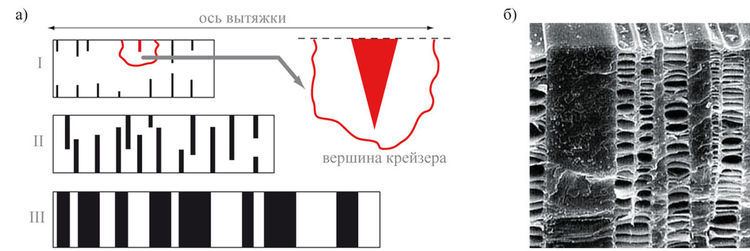 | ||
Rubber toughening is a process in which micron-sized rubbery domains are interspersed within a polymer matrix to increase the mechanical robustness, or toughness, of the material. Considering the significant advantages in mechanical properties that rubber toughening offers, most major thermoplastics are available in rubber-toughening versions; for many engineering applications, material toughness is a deciding factor in final material selection. This important property is entirely due to the small rubbery domains that aid in arresting crack propagation, thereby increasing toughness/energy needed to break the material.
Contents
Features
Rubbery domains that are no more than 1 micrometer in diameter are distributed in a typically brittle polymer matrix. The addition of these domains occurs via processes such as melt blending in a Rheomix mixer. The exact change in property is dictated by factors such as the rubber domain size, size distribution, and interfacial bonding. Regarding rubbery domain size, it is important that the size neither be too big nor too small. The former is a risk in the case of coarsening/Ostwald ripening, where domain sizes increase with time; this increase reduces the ability of the material to arrest crack propagation and therefore toughness deceases. The latter case has also proven to be an issue in practice where the size decreased below an effective size to promote toughening. In regards to interfacial bonding, there are processes in which graft copolymers at the interface are formed to prevent coalescence and therefore increase toughness. One such process is compatibilization, where functional groups or compatibilizing agents are added to initiate a reactive process.
Examples
Well-known rubber toughened polymers include high impact polystyrene (HIPS), rubber-toughened nylon, and acrylonitrile butadiene styrene (ABS). In HIPS, polybutadiene domains are dispersed in a polystyrene matrix; in rubber-toughened nylon, typically cis-polyisoprene is dispersed in a Nylon matrix; in ABS, polybutadiene domains are again used, but for both polystyrene and acrylonitrile. For all cases, the inclusion of the rubber domains make these rubber toughening versions much more suitable for high-toughness applications.
Failure
Rubber toughened plastics have proven to hold their mechanical integrity very well against monotonic loading. However, the study of fluctuating stresses and fatigue resistance shows more insight into the failure of these materials. Fluctuating stresses for ABS has been shown to cause failure of the material mainly through shear yielding; similar stresses for HIPS revealed that a process known as crazing was the main driving force for failure. Crazing produces fine cracks that typically precedes failure and can easily be seen via electron microscopy.
